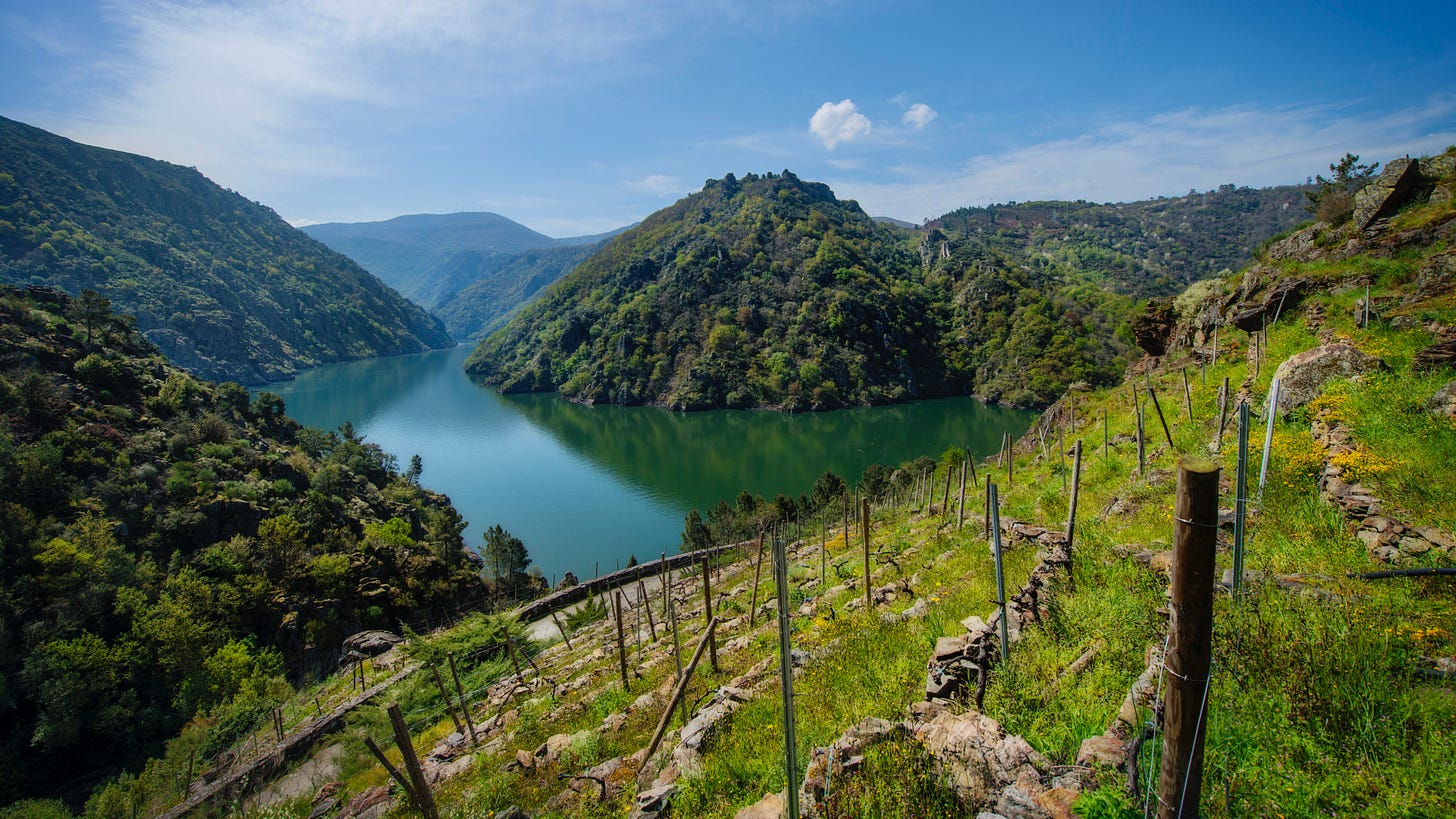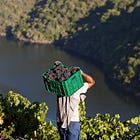Red Wines From Green Spain
Galicia is the counterpoint to the stereotypical big and oaky reds that too many people still associate with Spanish wine.
My favorite thing about traveling to Galicia is flying through Madrid. It has nothing to do with the city itself; in fact, on my most recent trip, I didn’t leave Barajas Airport. The best thing about the pit stop in Madrid is staring out the window during the hour-long flight to Galicia and seeing the ochre and brown tones of Spain’s central plains slowly melt into the vibrant green of its northwest. I never get tired of crossing the mountains that separate Galicia from Bierzo and Zamora and seeing the near-instantaneous shift. It’s a good visual reminder of just how diverse Spain is, and how different Galicia is from its neighbors.
Flying over Castilla y León, it’s easy to connect the dots and join the landscape to the wines. Ribera del Duero, Toro, Tierra de León… these come from brown Spain, yellow Spain, rolling hayfields, dry Spain, scorching in the summertime and cold in the winter Spain. The wines by and large reflect these contrasts by announcing themselves loudly: “here I am, I’m tempranillo, drink me!” You know the ones: 14.5 percent alcohol, heavy on the fruit and oak, drink now or hold for fifty years.
These are the sort of bold red wines that most people know Spain for, and they’re easy to put in a box. When wine students learn about Spain’s historically important regions like Rioja or Ribera del Duero, the focus is usually on classification systems based on time spent in the barrel, and a typical house style in which producers blend grapes from different vineyard sites.
Lest I oversimplify too much—of course this is changing. The regions known for making these “typical” Spanish red wines aren’t static either. Faced with climate change, producers are dialing back the oak and seeking out higher-altitude sites that allow for fresher wines. But even with these changes, there’s still a connective through-line that’s hard to miss. Regardless of barrel regime or planting site, wines from what I’ll call “brown Spain” carry an unmissable warmth and structure that makes them a perennial favorite and a dominant force in the Spanish wine scene.
Galicia, on the other hand, makes red wines that are harder to put into a box. “Green Spain” is well-known for its white wines, but its red wines should be on your radar too. Much like the Galicians themselves, whose default response to a yes or no question is some form of “it depends,” they twist and turn around a straight answer, offering multiple paths of interpretation. The sinewy, vegetal reds made from caíño and espadeiro from Rías Baixas become more muscular and toned as they give way to grapes like brancellao and sousón in Ribeiro, and the mencía and merenzao of Ribeira Sacra and Valdeorras end up cohabitating with tempranillo (known here as araúxa) in Monterrei. There’s a lot of diversity across five Denominaciones de Origen and five Indicaciones Xeográficas Protexidas, plus the maverick producers making wines outside of any appellation at all.
The top examples of Galician red wines are intimately linked to site in a way that would be the envy of other Spanish wine regions. Because of Galicia’s fragmented landscape, many growers work with multiple minifundios (small holdings), each with its own exposure, elevation, soil makeup, and grape varieties. The patchwork nature of viticulture here means that wines are more likely to be shaped by terroir than by a specific house style or winemaking formula. Even within a single region, you’ll find very different expressions. In Ribeira Sacra, wines from central, south-facing Amandi show clear differences from Atlantic, west-facing Ribeiras do Miño. In Ribeiro, grapes grown in the cooler, fresher, Avia Valley will show differently from the warmer, flatter Val do Miño. One parcel may give you ripe fruit, while another might be more floral and delicate, and another might be vegetal and crunchy.
Above all, these are exciting wines because they feel like a constantly shifting, new frontier in Spain. Take Rías Baixas for example. An area that was mostly planted to red grapes before the Albariño boom of the ‘80s has only seen a red wine revival within the last decade and change. Rodri Méndez told me on a visit in 2022 that he feels like they’re only just beginning to understand the potential of what they have. “At first, we didn’t know if it was the grape making the wine behave like it did or if it was the winemaking,” he told me. “Now, we’re beginning to understand the grapes and how best to work with them.”
I’ve written about the potentially life-changing effects of drinking Ribeira Sacra, but I want to highlight more of the Galician red wines that anyone who wants to expand their horizons should know.
A Roundup of Reds From Galicia
Below are some accessible gateway wines for exploring the red wines of Galicia. Bottle recommendations and tasting notes for paid subscribers only.





